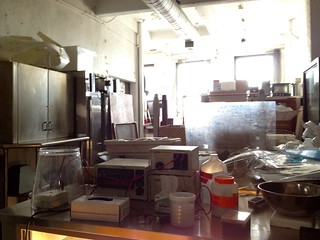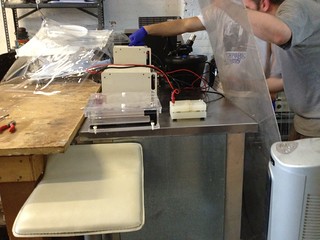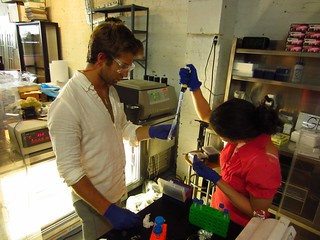Team:NYU Gallatin/Project/Transforming
From 2012.igem.org
(Difference between revisions)
| Line 51: | Line 51: | ||
<div class="content clearfix"> | <div class="content clearfix"> | ||
| - | <div class="field field-name-body field-type-text-with-summary field-label-hidden"><div class="field-items"><div class="field-item even"><p><img src="http://farm9.staticflickr.com/8452/8052046690_74e9f03b01_n.jpg" class="border" style="float: left; margin-right: 20px; margin-bottom: 15px;" />With regard to transformation, electroporation is well-known for its higher cell wall penetration rate and its efficiency on higher-organism cells, mammalian cells in particular. We used electroporation on E. Coli cells, adapting and improving available electroporation protocols to optimize transformed colony yield. <img src="http://farm9.staticflickr.com/8454/8052039349_973bb2a2b1_m.jpg" class="border" style="float: right; margin-left: 20px; margin-bottom: 15px; margin-top: 20px;" /> We hypothesized that corrected voltage and cell preparation procedures would allow us to successfully transform. Acetobacter Xylinum through electroporation. Tests included E.Coli and Acetobacter Xylinum transformation for RFP and GFP expression. Pure Acetobacter Xylinum cultures were also grown in media for several weeks and a chart has been prepared to describe and detail growth patterns. Using a spectrophotometer, light absorbency readings were taken regularly to allow for the collection of daily data. Through this measurement technique, we also determined optimal growth phases for the preparation of Acetobacter Xylinum as an electro-competent cell. </p> | + | <center><img style="border: solid black 1px; margin-bottom: 20px;" src="http://farm9.staticflickr.com/8311/8052386481_6e29d9d7c0_c.jpg" width=683 /></center><div class="field field-name-body field-type-text-with-summary field-label-hidden"><div class="field-items"><div class="field-item even"><p><img src="http://farm9.staticflickr.com/8452/8052046690_74e9f03b01_n.jpg" class="border" style="float: left; margin-right: 20px; margin-bottom: 15px;" />With regard to transformation, electroporation is well-known for its higher cell wall penetration rate and its efficiency on higher-organism cells, mammalian cells in particular. We used electroporation on E. Coli cells, adapting and improving available electroporation protocols to optimize transformed colony yield. <img src="http://farm9.staticflickr.com/8454/8052039349_973bb2a2b1_m.jpg" class="border" style="float: right; margin-left: 20px; margin-bottom: 15px; margin-top: 20px;" /> We hypothesized that corrected voltage and cell preparation procedures would allow us to successfully transform. Acetobacter Xylinum through electroporation. Tests included E.Coli and Acetobacter Xylinum transformation for RFP and GFP expression. Pure Acetobacter Xylinum cultures were also grown in media for several weeks and a chart has been prepared to describe and detail growth patterns. Using a spectrophotometer, light absorbency readings were taken regularly to allow for the collection of daily data. Through this measurement technique, we also determined optimal growth phases for the preparation of Acetobacter Xylinum as an electro-competent cell. </p> |
<p><img src="http://farm9.staticflickr.com/8317/8052051236_7e6f368694_n.jpg" class="border" style="clear: left" /> <img src="http://farm9.staticflickr.com/8182/8052044117_7b58cb9ea3_n.jpg" class="border" /></p> | <p><img src="http://farm9.staticflickr.com/8317/8052051236_7e6f368694_n.jpg" class="border" style="clear: left" /> <img src="http://farm9.staticflickr.com/8182/8052044117_7b58cb9ea3_n.jpg" class="border" /></p> | ||
<h1>Protocols</h1> | <h1>Protocols</h1> | ||
| Line 99: | Line 99: | ||
<li>Incubate the culture for 1 hour at 37 degrees with gentle agitation</li> | <li>Incubate the culture for 1 hour at 37 degrees with gentle agitation</li> | ||
<li>After incubation, take 200mL of the sample and plate onto appropriate agar, use beads to spread the sample around the plate</li> | <li>After incubation, take 200mL of the sample and plate onto appropriate agar, use beads to spread the sample around the plate</li> | ||
| - | </ol></div></div></div> </div> | + | </ol><p></p><center><img src="http://farm8.staticflickr.com/7121/7864390690_87fb603e4b_n.jpg" class="border" /> <img src="http://farm9.staticflickr.com/8431/7864392046_b300d7dd16_n.jpg" class="border" /></center> |
| + | </div></div></div> </div> | ||
| Line 111: | Line 112: | ||
<div class="content"> | <div class="content"> | ||
| - | <div class="view view-lab-notes view-id-lab_notes view-display-id-block_1 view-dom-id- | + | <div class="view view-lab-notes view-id-lab_notes view-display-id-block_1 view-dom-id-c6a9b70b6f09d2a1ba5fb778386864f1"> |
Revision as of 02:22, 4 October 2012
 "
"

 With regard to transformation, electroporation is well-known for its higher cell wall penetration rate and its efficiency on higher-organism cells, mammalian cells in particular. We used electroporation on E. Coli cells, adapting and improving available electroporation protocols to optimize transformed colony yield.
With regard to transformation, electroporation is well-known for its higher cell wall penetration rate and its efficiency on higher-organism cells, mammalian cells in particular. We used electroporation on E. Coli cells, adapting and improving available electroporation protocols to optimize transformed colony yield.  We hypothesized that corrected voltage and cell preparation procedures would allow us to successfully transform. Acetobacter Xylinum through electroporation. Tests included E.Coli and Acetobacter Xylinum transformation for RFP and GFP expression. Pure Acetobacter Xylinum cultures were also grown in media for several weeks and a chart has been prepared to describe and detail growth patterns. Using a spectrophotometer, light absorbency readings were taken regularly to allow for the collection of daily data. Through this measurement technique, we also determined optimal growth phases for the preparation of Acetobacter Xylinum as an electro-competent cell.
We hypothesized that corrected voltage and cell preparation procedures would allow us to successfully transform. Acetobacter Xylinum through electroporation. Tests included E.Coli and Acetobacter Xylinum transformation for RFP and GFP expression. Pure Acetobacter Xylinum cultures were also grown in media for several weeks and a chart has been prepared to describe and detail growth patterns. Using a spectrophotometer, light absorbency readings were taken regularly to allow for the collection of daily data. Through this measurement technique, we also determined optimal growth phases for the preparation of Acetobacter Xylinum as an electro-competent cell. 




















